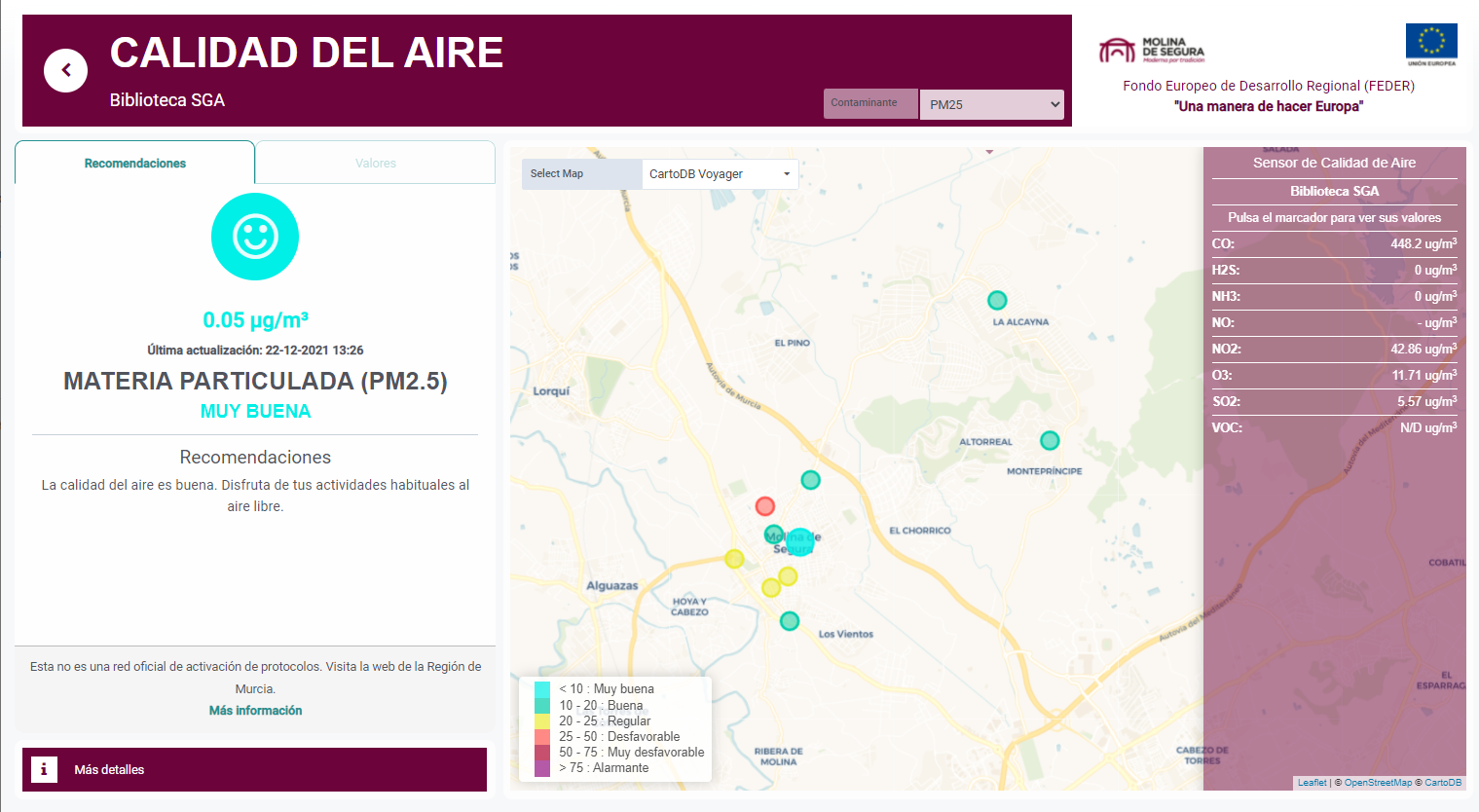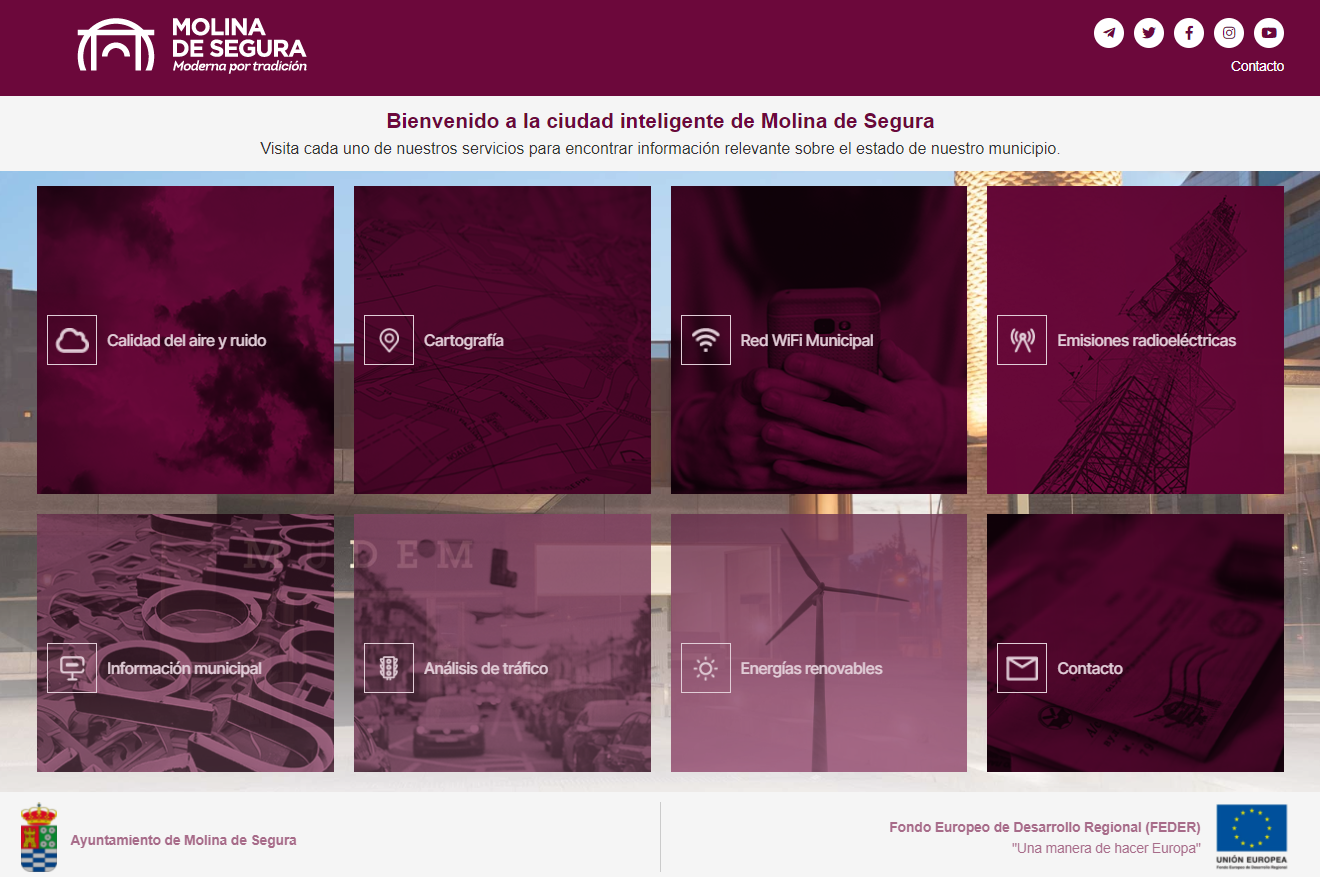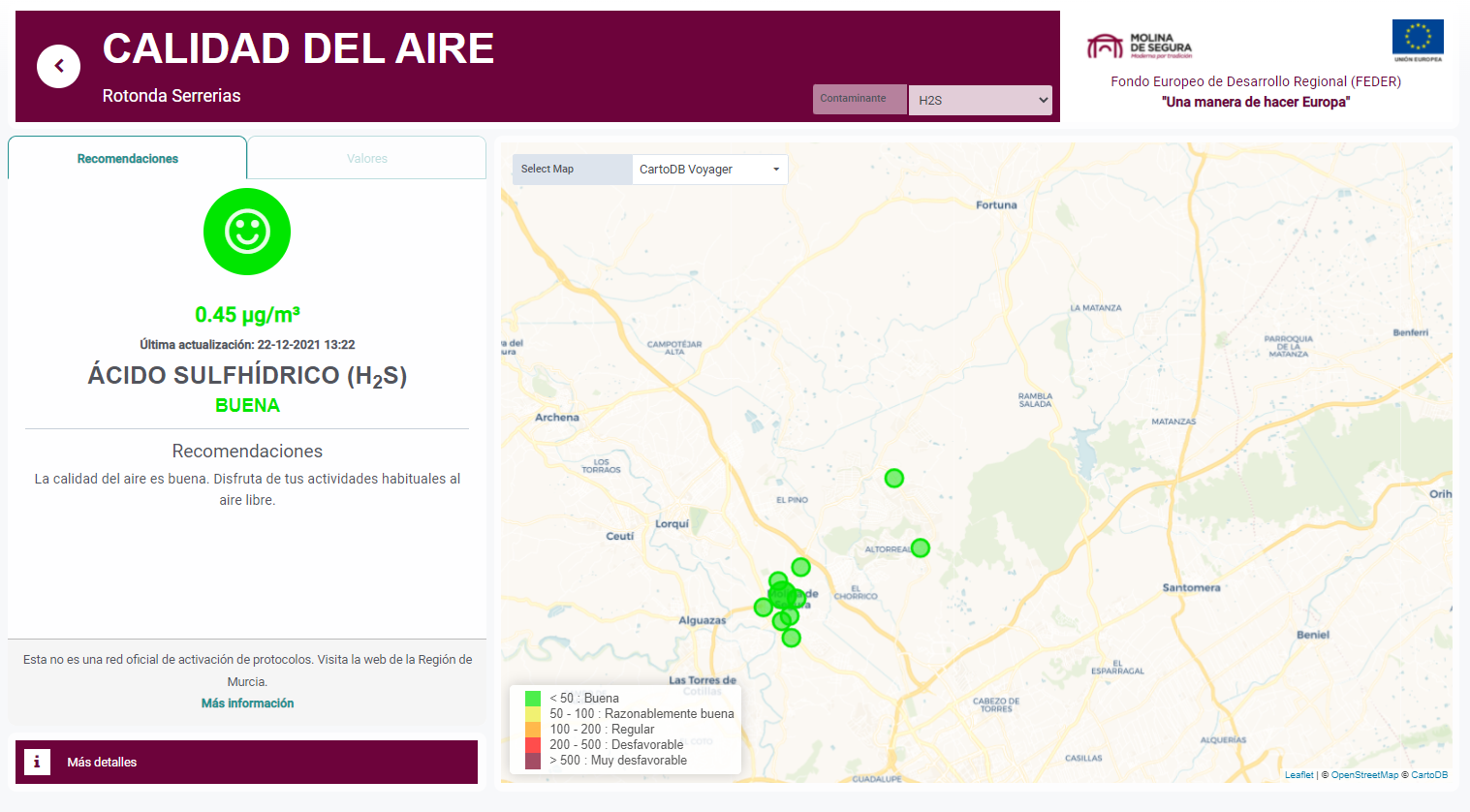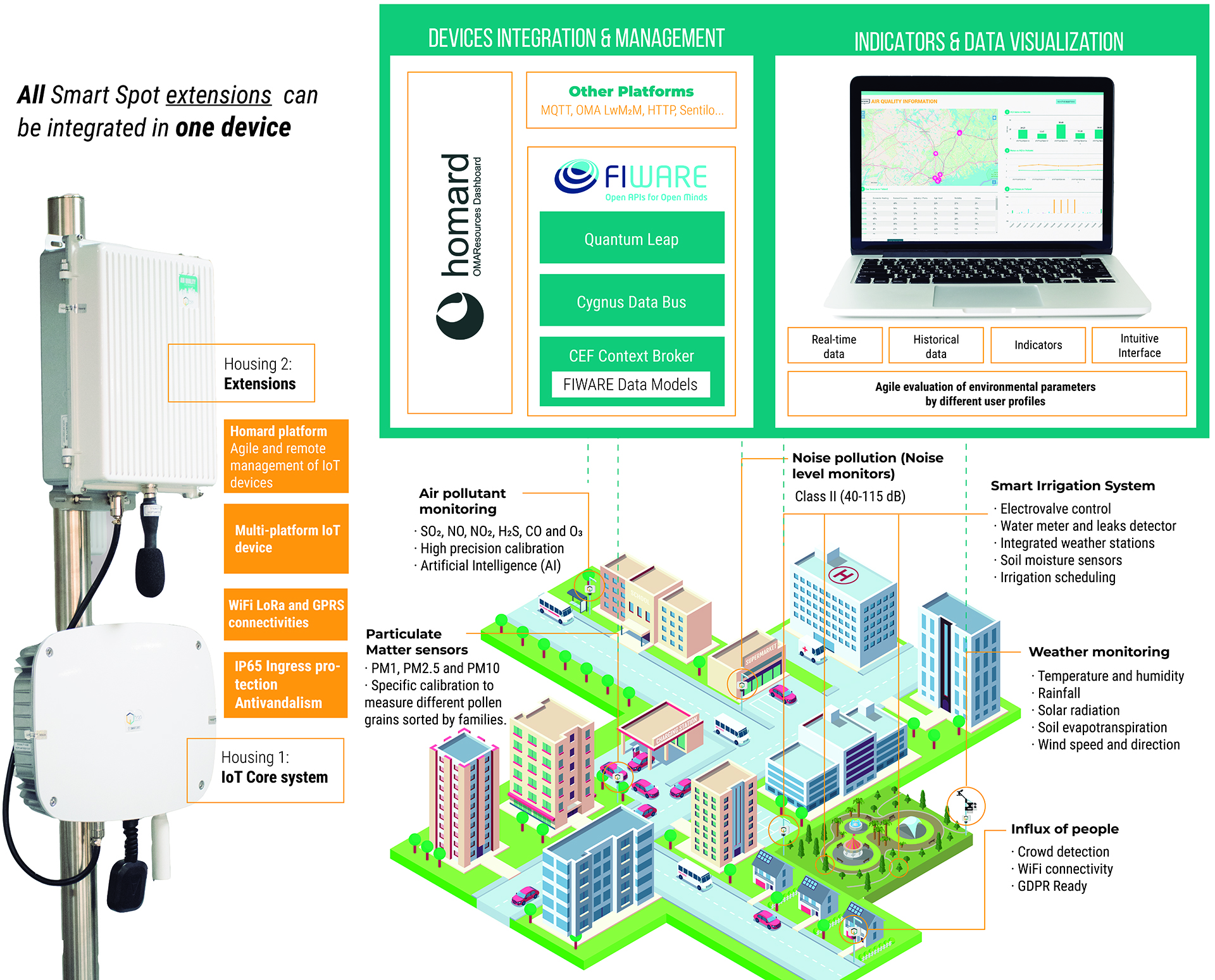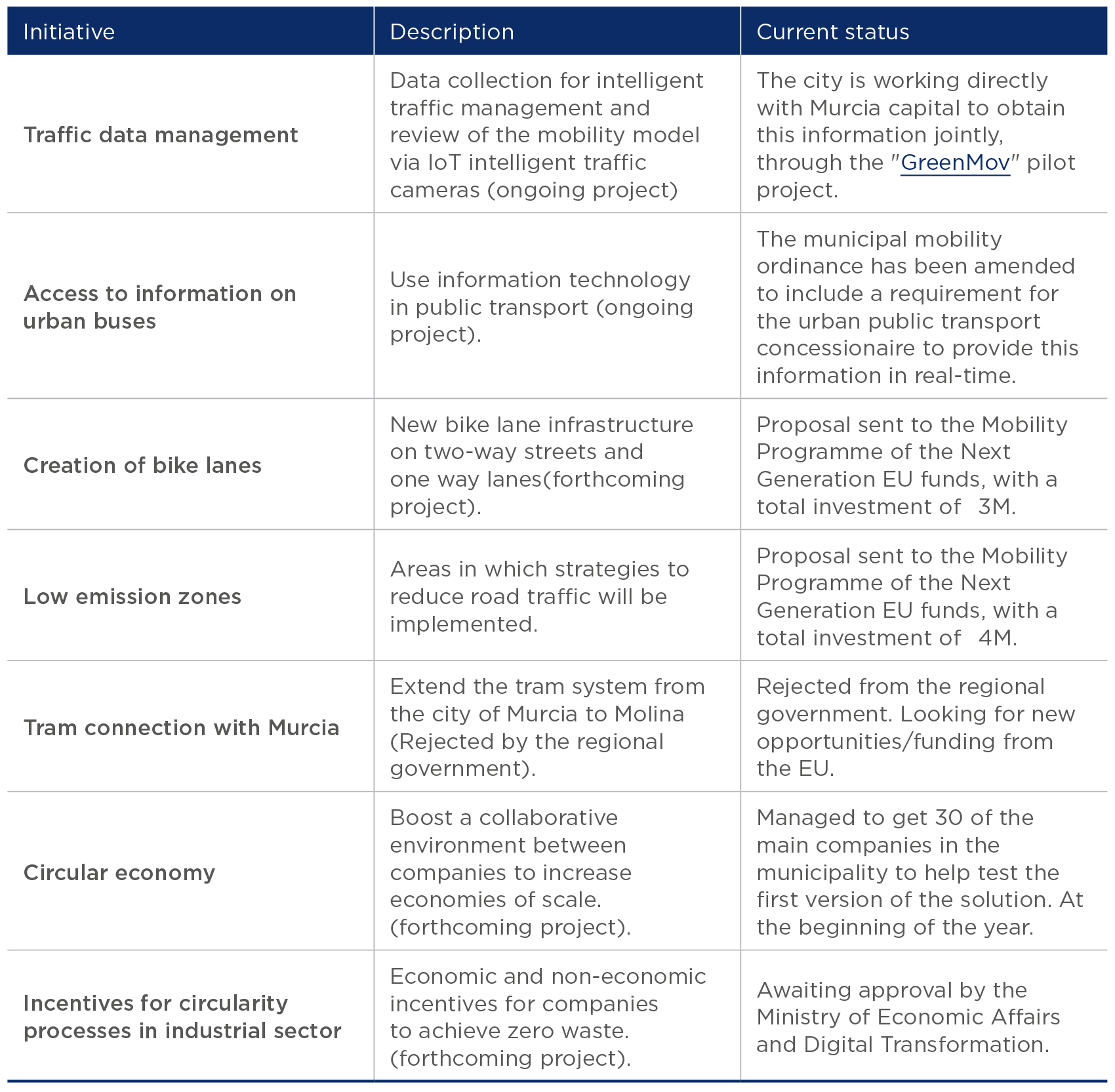Challenge & Context
Molina de Segura is the fourth largest municipality in the large metropolitan area of the autonomous community and province of Murcia and possesses the highest income per capita per inhabitant in this region due to a concentration of leading national companies. Molina de Segura is one of the industrial epicentres of the region and as such, various issues such as air and noise pollution, caused by industry and logistics, need to be dealt with. To tackle these issues, Molina de Segura designed a master plan to implement changes for a more livable, safe, digital and sustainable city, eventually becoming a Smart City, which has evolved towards the current Policy Programme executed under the ERDF programme “EDUSI Molina Avanza Contigo”.
Molina de Segura has experienced positive changes and modernization in recent years, in large thanks to various European projects implemented.
Financial tools and policy programmes such as ERDF (Sustainable development funds), UIA (Urban Innovation Actions) and CEF (Connecting Europe Facilities – Horizon2020) require a deeper level of compromise, monitoring of KPIs and sustainable development actions (i.e. reduction of emissions, enhancement of quality of life, and steps towards a green economy). As an instrument designed to raise awareness and act as a call to action for citizens and public administrations, legal implications and limitations to financial access have been imposed on those European cities who have exceeded maximum pollution levels. For this reason, FIWARE and the integration of advanced monitoring systems with highly guaranteed/certified data quality, AI-based modelling and forecasting algorithms, as well as the integration of contextual data over dashboards/DataViz are crucial for the support of sustainable investment and are expected to be included in the recently-signed EU Green Deal initiative.
The current challenge in the management of sustainable investments and access to grant opportunities is based on three main issues confronting urban planners:
- Lack of valuable data: Evidence-based indicators;
- Difficulties to controlling regulatory compliance levels: Violation of laws and regulations;
- Lack of a global liveability index and social welfare: A comprehensive understanding of the global situation, the main needs and the best solution to address them.
Moreover, the recent EU Green Deal has established a new financial model and support for cities fighting climate change. Under the initiative, programmes such as the Innovation Fund (worth up to 10 billion euros) that allocate 40% of the budget at the beginning of a given project and ensure that 60% of the budget will be allocated later, depending on the results achieved/demonstrated by the projects. Therefore, there is a strong need to ensure evidence-based and data-driven actions. Most importantly, given the European commitment to become a sustainable continent by 2050, with a 55% reduction in CO2 emissions by 2030, it is time to look head-on at climate change and make a serious commitment.
Given such relevant challenges, innovative companies, such as HOPU (Human-Oriented Products for Urban-environments), are assisting cities in meeting their goals, providing them a range of AI-powered services based on contextual data and IoT products for effectively addressing their specific urban issues.
By relying on the potential of data with technologies, such as Artificial Intelligence, the Internet of Things, and the FIWARE ecosystem, the city of Molina is currently planning and managing several sustainable urban actions with the aim of transitioning its ecosystem to become more sustainable and efficient via innovative actions.
To this respect, the main goals of the city are focused on improving urban mobility, lowering levels of air pollution and leveraging the potential of the circular economy. All these goals are being addressed through better informed – data-driven solutions that assist their decision-making based on evidence and provide continuous monitoring of the evolution of the actions taken.
In this context, companies, such as HOPU, are providing solutions for different verticals of a city, such as environment and air quality monitoring (climate change mitigation and improved quality of life of population), that enable customers to understand the environmental situation of each territory, according to its specific characteristics. In fact, one of the company’s priorities is to involve urban planners and decision-makers in the process, guaranteeing that the deployments are understandable, intuitive and usable, making the Smart and Sustainable Cities sector more accessible and agile for the city’s entire ecosystem.
Figure 1 . Open visualizer of data in Molina de Segura, Murcia Region (Spain)
Solution
Molina de Segura has deployed its Smart City platform based on high-quality data and the FIWARE Open Source approach, using the Orion Context Broker as a central part of the platform. The Context Broker Generic Enabler is the core and mandatory component of any “Powered by FIWARE” platform or solution. The the case of Molina de Segura, the platform integrates smart verticals/services of the city based on contextual municipality information (some of them are currently being developed and deployed) that allow users to monitor and understand their context thanks to the innovative predictive systems that support decision making.
Figure 2 . Smart City platform interface: integration in different verticals, such as air quality and noise monitoring, cartography, renewable energy, traffic analysis and municipality information.
A network of 10 IoT air quality sensors have been deployed around the city to enable a real-time monitoring service of the environment that shows existing pollutant emission levels and assists urban planners in carrying out mitigation actions whilst raising awareness of local citizens. The network, composed of a set of devices called Smart Spots, measure gas levels such as NO, NO2, H2S, SO2, CO, CO2, and O3, detect toxic substances, such as alcohol and volatile organic compounds (VOCs), and particulate matter (PM) to identify specific nanoparticles such as dust (PM10), pollens (PM10-PM40), pollutants (PM2.5), and viruses (<PM1). In addition, sound metres have also been integrated as part of the solution to ensure that noise levels are not exceeding the limits established to ensure a healthy urban environment.
As a result of the actions and deployments performed, Molina de Segura has unified the available data into unique indicators that contextualise, model, and forecast the environment for informed decision making based on its specific characteristics and management team.
Figure 3 . Example of interface showing PM levels in certain areas of the city
HOPU deployed the Smart City platform and the IoT network infrastructure. Its services include air quality indicators to ensure that the United Nations’ Sustainable Development Goals (SDGs) can be achieved.
For example, the Marketplace of Intelligent Cities Challenge, demonstrates publicly the link between the installed solution and its impact to the selected SDGs.
In particular, HOPU focuses on helping sustainable cities and communities working on climate actions via three main areas:
- Air quality index to know the state of air pollution in urban areas;
- Pollen service to monitor the particulate matter levels that may affect the population at risk, such as asthmatic, elderly or allergies;
- Sound level tracking to assess noise pollution in cities that affect inhabitants’ mental health;
- People flow to analyse crowd impact within the ecosystem.
To offer different high-quality indicator services, HOPU provides comprehensive solutions which integrate visualisation tools and IoT devices, permitting the deployment of smart infrastructures, enabling the collection of environmental data from urban areas and creating specific liveability indicators to support smart decision-making processes. Specifically, the devices enable air pollutants, greenhouse gases, particulate matter (including pollen, dust, VOCs), weather, noise pollution and people flow monitoring, providing relevant environmental data, which is then also cross-checked with external data sources such as private data, open data and satellite data. The IoT equipment provides accurate data with more than 80% accuracy in environmental monitoring, 98% in sound level monitoring and 90% in people flow monitoring.
Figure 4 . Schema of the smart ecosystem based on FIWARE and IoT sensors for different verticals of cities
Following the FIWARE Open Source approach and thanks to the Orion Context Broker, HOPU integrates datasets from various data sources such as energy consumption or water consumption, social media data, health aspects, among others, to offer a solution that allows the analysis of all contextual data, and provides simplified indicators for decision-making.
How it works
It’s about a comprehensive solution that combines IoT, visualisation and analysis services, to enable a smart and sustainable ecosystem.
Based on the FIWARE Context Broker, the visualisation tool and indicators, the solution covers the monitorization of contextual data through the FIWARE-ready IoT devices, in addition to the integration of third-party data (different datasets) from satellite, open data, private data, census, social statistics, etc.
Environmental monitoring IoT devices
Smart Spots are configurable IoT Internet of Things (IoT) devices. They allow the monitoring of other environmental factors, such as harmful/greenhouse gases, particulate matter such as pollen, dust and VOC, temperature/humidity, and noise, integrating other monitoring capabilities, such as outdoor people flow, electricity consumption and it can include weather stations to monitor rain, wind and solar radiation. Including all these sensors in a single device provides savings in installation, maintenance, management and communication. It is offered in multiple versions, including Wi-Fi, LoRa/SigFox or GSM/GPRS, and the LwM2M and MQTT protocols.
Data quality/reliability is a critical differentiation aspect with regards to other solutions. Smart Spots offer certified data quality as IEEE P2510, validations by external institutions such as the Environmental Centre (CETENMA), demonstrating an excellent correlation concerning reference data sources and a guarantee and certification of calibration for every individually sold system by an accredited calibration laboratory (ISO 17025) by an ENAC accredited body. Smart Spots are maintained with the (FIWARE-compatible) AI-empowered cloud platform Homard for preventive maintenance, fatigue compensation, and data quality and calibration evolution optimization.
These devices are a modular and cost-effective solution adaptable to specific needs, supporting reliable and high quality data for environmental monitoring, gases, and toxic substance identification. This is extensible with other contextual parameters such as noise, affluence of people and the relevant data sources for monitoring that support the understanding of the status to enable data-driven and evidence-based decision-making.
Data analysis/visualisation
The data visualisation service is FIWARE-based, enabling the configuration of alerts, data analysis, dashboard creation, multi-parameter monitoring/correlation, and integration/communication with other systems via MQTT, OPC-UA/Modbus, Open APIs and direct support of existing Smart City platforms, based on FIWARE.
The visualisation data tool, based on FIWARE, promotes the effective use of Open Source resources, integrating datasets from utilities (energy/water), social (transport/affluence) and health (census/statistics)in addition to the contextual monitoring from IoT sensors. As a result, the solution enables a contextual-evidence-driven tool for systematic data collection, urban planning, and data analysis empowered by AI. This brings a higher capacity for understanding the needs of cross-sectoral aspects (climate, sociology, urbanism), providing indicators, and correlations/analysis to identify the best potential solutions to provide a healthier, cleaner environment whilst combating climate change. This action is aligned with strong urban policies. Strategic urban planning is the key to creating supportive healthy environments and ensuring health and equity considerations are integrated throughout planning processes, investments, and policy decisions.
Benefits & Impact
The main competitive advantage of the creation of Smart City ecosystems is the unification of steps and systems from the data collection phase to the conclusion development for decision-making in a single and usable tool. Due to this global tool, cities can reduce the time dedicated to making informed decisions and automatically ensure that the decisions are more effective. In addition, the device’s configuration can benefit urban planners with regards to saving costs in management, the integration of different sensors, and installation.
The HOPU Smart City Ecosystem for environmental monitoring includes four main pillars that an informed decision-making solution must have unified into a single product:
- A final solution adapted to each territory through interaction with the cities themselves. All the HOPU solutions are city driven and they grow based on the city’s interactions.
- Use all available data sources in the territory as a global territory vision, including open data, private data, satellite data and social data from census and statistics.
- Simplification and abstraction to reach clear indicators, making the understanding of Big Data for different urban planner profiles easier.
- Adaptation of indicators to required regulations and parameters that cover the regulatory needs of territories, providing support in controlling and avoiding sanctions.
It should be noted that the solution has been deployed and validated by major Spanish cities such as Madrid, Cartagena, Onda, Badajoz, Santander and La Palma. Moreover, it has also been deployed in Bruges and Mechelen (Belgium), adding to a list of more than 100 cities throughout the world.
HOPU’s experience with a wide range of cities demonstrates the value of this service in the market and how it contributes to the knowledge revolution in the field of environmental health, following the principles of the World Health Organization (WHO) by creating a system to exploit data for urban health.
In the case of Molina de Segura, the platform has improved city management for municipal technicians, as it provides reliable, interesting and impacting data. As it has also had a positive impact on citizens, the city has become more open through the availability of open data in real-time.
This platform is the main nucleus for the important mobility projects that will be carried out thanks to Next Generation funds, consisting of developing a low-emission zone and bike lanes in urban areas and behavioural tracking using artificial intelligence.
Added value through FIWARE
Molina de Segura has been able to leverage the potential of FIWARE Smart City platform components as an open source ecosystem based on European standards. This has enabled the development of different solutions for Smart City verticals, utilising enablers, such as the Orion Context Broker and IoT agents.
This technological structure, which follows a common European standard, has brought a very relevant angle for the public administration market towards being more integrable, open and standardised. The Context Broker and FIWARE ecosystem have provided powerful open standard APIs for integrating and managing the contextual information from multiple data sources. To this respect, the FIWARE ecosystem has facilitated Molina in the implementation of scalable Smart City vertical services based on real-time and time series data, adapted to its needs and meeting relevant standards.
Regarding technical specifications, the city has taken advantage of implementing Smart City solutions based on FIWARE and Context Broker:
- Open source IoT platform: based on open source and developed by a large experienced community.
- Based on open standards: OMA NGSI and recognized as standard by the European Union.
- Highly interoperable: FIWARE ecosystem has a positive impact on the smart platform interoperability.
- Homogenization and management of data integrated.
- Versatility in the creation of different applications, based on a well-defined API and supported by a large number of use cases and services already available.
- Interoperability with the main IoT protocols available on the market (MQTT, LoRa, Ultralight or OMA LwM2M).
- Data storage of generic databases: relational and non-relational databases and indexed databases.
Next Steps
Molina de Segura is currently facing several challenges via innovative initiatives which are being implemented on the platform. The following table summarises the priorities and specific actions/initiatives and their current status:
Figure 5 . Next Activities and Actions
References
- Final resolution ERDF funds: aid of 10 million euros to finance the EDUSI “Molina 2020 Avanza Contigo”
- A network of sensors will measure air quality to better combat pollution in Molina de Segura
- More than 40 cameras will monitor traffic and security on the streets of Molina
- The Molina de Segura City Council is committed to the Internet of the future thanks to the help of the ERDF to develop the EDUSI Molina 2020 Avanza Contigo
- Molina de Segura joins the Spanish Network of Smart Cities
- Molina is member of “Cities4CSR” project of the Urbact project
- Molina de Segura City Council participates in the VIII Technical Committee of the Spanish Network of Smart Cities
- Molina de Segura is integrated in CRIsol Data Center

